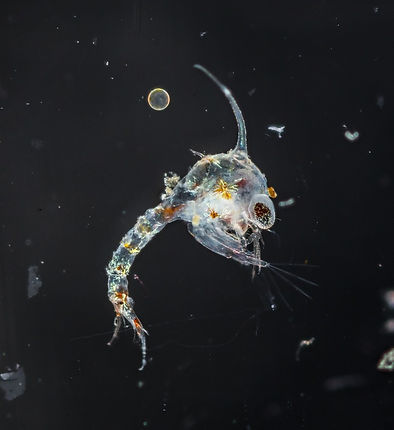Crustaceans from the Meroplankton
Crustaceans living on the seashore have a planktonic larval stage where they feed, grow, disperse and develop until adulthood when they settle out on to the shore. Like insects this is a process of metamorphosis so the juvenile state is quite different to the adult. The species covered here include barnacles and decapods (e.g. crabs)
Acorn Barnacles

Adult barnacle attached to a rock under water feeding, collecting microscopic material with its hairy legs.

Nauplius larva (about 600 microns across) which passes through 6 moults to reach the final stage, the cyprid.

Cypris stage larva. It is non-feeding with plenty of stored lipid. It may survive a few days as it settles out on to a hard substrate to complete metamorphosis into an adult, gluing itself permanently to the surface

A large group of nauplii with 2 Calanus copepods. Nauplii can be extremely abundant in Spring creating a huge biomass in the plankton. although they are invariably present throughout the year.
Large numbers of light brown cyprids have settled on to a rocky shore drawn near by other barnacles. Juvenile barnacles (often called spat) are already on the rock and a limpet (top right of photo)

Decapods

Zoea larval stage of Porcellana platychelles, the broad-clawed porcelain crab
This group, consisting of crabs and shrimps, have a larval stage called the zoea, the form of which varies between species. Large and abundant spines on the body help by giving drag, slowing the rate of sinking

Zoea larval stage of Carcinus maenas, the common shore crab


The zoea morphs into a megalopa larva as it gradually settles out of the plankton to live on the shore before a final change to an adult

Other Crustaceans Encountered in the Plankton
ISOPODA
These flattened-shape crustaceans include the terrestrial woodlice. Marine Isopods have a huge number of parasitic forms and the specialised family Gnathiidae have around 170 species worldwide but only a handful in Europe. Gnathia maxillaris is common on Haven shores and adults, around 5mm long, live among barnacles. The female releases up to 100 embryos. These are zuphea larvae, active swimmers in the plankton that can spend weeks finding a fish on which to ectoparasitise and suck blood for a few days. The middle segments expand with the food and it becomes a praniza larva, sinking to the shore where the meal is slowly digested. After sometime it returns to the plankton as a zuphea stage 2 to repeat the process, and then a third time before becoming an adult. The female survives on the food attained during the parasitic phase and live for a year. The strange life cycle of these isopods is not fully understood as following them in nature is difficult. This account is from a paper by Tanaka (2007) in Plankton Benthos Research and is based on species from the Pacific.

A stage-3 zuphea larva of Gnathia, approx 3mm in length

A final stage praniza larva or early female of Gnathia, approx 4mm in length
This is a Bopyrid species. A very small (200 microns) isopod larva called a cryptoniscus larva. The odd one or two appear in spring when copepods are about, attaching to the outside as an ectoparasite.


AMPHIPODA
Hyperia galba. Almost a centimetre in length it is a very occasional find in the plankton sample as it is a semi-parasite on the inside of the bell of jellyfish. It may not always be parasitic as it can feed on their food too as it lives near the mouth
Mysida
The very transparent larval stage of a mysid or opossum shrimp (shrimp-like, not true shrimps). In the "tail" or uropods are 2 statocysts (balance type organs) looking like a pair of eyes. These primitive crustaceans are known as opossum shrimps because the adult has a pouch for housing the developing eggs. Common in the nearby Gann Estuary the planktonic young spill out into the water below Dale

